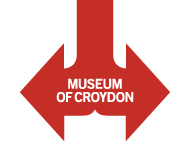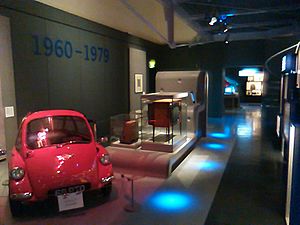Museum of Croydon facts for kids
 |
|
 |
|
| Lua error in Module:Location_map at line 420: attempt to index field 'wikibase' (a nil value). | |
| Established | 1995 (as Lifetimes) 2006 (as Museum of Croydon) |
|---|---|
| Location | Croydon, London |
| Type | Local and social history museum |
| Public transit access | |
The Museum of Croydon is a cool place to explore the history and culture of Croydon in London, England. It's located inside the Croydon Clocktower building. This museum is all about showing off amazing historical items and stories from the people of Croydon. It's owned and managed by the local council.
You'll find the main part of the museum on the upper ground floor of the Croydon Clocktower. There's also the Riesco Gallery on the lower ground floor. This gallery has ancient Roman and Anglo-Saxon collections, plus a special collection of beautiful Chinese ceramics. The museum first opened in 1995 and was called Lifetimes. After a big makeover, it reopened in 2006 with its current name. The best part? It's free to visit, and many of the displays are interactive, meaning you can touch and play with them!
Contents
History of the Museum
Why Croydon Needed a Museum
For a long time, Croydon didn't have its own local museum, even though many people wanted one. However, the local council had collected over 2,000 pieces of art. They also had the Riesco Collection, which is a fantastic group of Chinese pottery and porcelain. This collection was given to Croydon in 1964 by a local collector named Raymond Riesco.
In the 1980s, people thought Croydon seemed a bit "boring." So, the Council decided to spend a lot of money to create a new arts, library, and cultural center. This new place was named Croydon Clocktower, and it was planned to include a brand new local museum.
Lifetimes: The First Museum
Planning for the museum took five years, from 1989 to 1994. During this time, they did a lot of research to find out what people wanted from a museum. They wanted to make sure it was interesting and useful for everyone, especially those who didn't usually visit museums.
The research showed that words like "Croydon," "museum," and "history" didn't sound very exciting to people. So, the new museum was given a more neutral name: "Lifetimes." Sally MacDonald, who was in charge of the museum, explained that it needed to be "new, different, modern, daring, high profile, glossy, sponsorable and popular." It was meant to help make Croydon look better to the outside world.
Lifetimes opened in March 1995. It told the story of Croydon and its people from 1840 up to the present day, focusing a lot on the time after 1939. Many of the items on display were borrowed from local residents. A lot of information came from interviews with people about their memories. Instead of glass cases and labels, the museum used computer screens to explain things.
Lifetimes won awards in 1995 and 1996 for its innovative approach. Experts praised it for being a "brave, bold and intelligent approach" to showing the complex history of modern Croydon. However, some people also had criticisms. Some felt it focused too much on certain groups or relied too heavily on new technology. Also, local historians were disappointed that the story only started from 1840, leaving out much of Croydon's earlier history.
For example, some felt it didn't show anything about Croydon's possible Roman beginnings. It also missed out on its long history as a manor and palace for the Archbishops of Canterbury. Instead, it showed items like a Hell's Angel's jacket. The museum also published leaflets about different ethnic groups in Croydon. One of these was removed after complaints about its political views.
Museum of Croydon: The New Look
Lifetimes closed in December 2004 for a big renovation and redesign. It reopened in September 2006, now called the Museum of Croydon. The new design won an award in 2007. Many of the old exhibits and themes from Lifetimes were kept. However, some changes were made. For example, the historical story now started from 1800 instead of 1840. The Riesco Gallery was also updated to show items from Croydon's Roman and Anglo-Saxon collections, alongside the Chinese ceramics.
What You Can See at the Museum
The Museum of Croydon has many exhibits that show different parts of Croydon's history, from 1800 to today. When you enter the main galleries, you can choose to go through a door marked "Then" or "Now." This means you can follow the story in order from oldest to newest, or go backwards from newest to oldest!
On the lower ground floor, you'll find the Riesco Gallery. This gallery displays ancient Roman and Anglo-Saxon items, as well as the beautiful Riesco Collection of Chinese ceramics.
Some of the cool things you can see include:
- Exhibits about the important black composer Samuel Coleridge-Taylor (1875–1912), who lived most of his life in Croydon.
- Items that the local IKEA store in Purley Way sold when it first opened, like furniture and old catalogues.
- Things from the local football club, Crystal Palace, such as a contract belonging to footballer Peter Taylor.
The Art Collection
The museum also has a large art collection with over 2,000 pieces. This includes paintings, prints, drawings, and sketches. Only a small number of these are on display at any one time. Many of the artists in the collection have strong connections to Croydon, like Cicely Mary Barker and Bridget Riley. You can see over three hundred of these artworks online on the Art UK website.
Museum Recognition
In December 2009, the museum received official recognition from the Museums, Libraries and Archives Council. This showed that the museum was managing its collections well and providing good facilities for visitors, meeting national standards.
However, in November 2013, the museum lost this recognition. This happened because Croydon Council decided to sell 24 items from the Riesco Collection at an auction. This was seen as going against the rules of the Museums Association, which is an organization that sets ethical standards for museums. Because of this, Croydon Council also left the Museums Association.

